Development and Optimization of Geopolymers Made with Desert Dune Sand and Blast Furnace Slag
Abstract
:1. Introduction
2. Experimental Program
2.1. Materials
2.2. Development of Geopolymer Mortar Mixtures
2.3. Sample Preparation
2.4. Test Methods
2.5. Cost and CO2 Footprint Calculations
3. Optimization Methods
3.1. Taguchi Integration
3.2. Optimization by TOPSIS Method
4. Results and Discussion
4.1. Flowability and Setting Time
4.2. Fresh and Hardened Densities
4.3. Compressive Strength
4.4. Water Absorption
4.5. Sorptivity
4.6. Environmental and Economic Impact Analysis
4.7. Analysis of Variance (ANOVA) Analysis
4.8. Taguchi Optimization
4.9. TOPSIS Optimization
4.10. Prediction of the DDF-BFS Geopolymer Mortar Properties
5. Conclusions
- The replacement of BFS with DDF reduced the flowability of geopolymer mortars. A flowability of at least 153 mm could be attained with 75% DDF replacement. Reducing SS/SH and SH molarity to at most 1.5 and 10 M, respectively, increased flowability.
- The final setting time of DDF-BFS blended geopolymer mortars increased with BFS replacement by DDF. The average final setting time increased from 14.1 min for 0% DDF to 14.2, 19.5, 24.3, and 32.8 min with 25, 50, 75, and 100% DDF replacement, respectively. Lowering SH molarity below 10 M resulted in longer setting times.
- The fresh and hardened densities of DDF-BFS blended geopolymer mortar increased with 25% DDF replacement but decreased at higher replacement levels (50, 75, and 100%). This was attributed to the dilution of the matrix and reduced compactability of the mortar with high DDF replacement. Meanwhile, the densities were marginally affected by the AAS/B, SS/SH, and SH molarity.
- Compressive strength followed similar trends at 1, 7, and 28 days. The replacement of BFS by 25% DDF increased the strength up to 56.5 MPa, owing to enhanced particle packing density and particle gradation. In fact, to attain a compressive strength above 40 MPa, mixtures should be proportioned with 0–25% of DDF, 0.5–0.55 of AAS/B, 1.5–2.0 of SS/SH, and 10–14 M of SH solution. Further increasing DDF replacement to 50, 75, and 100% reduced the strength to, on average, 15.6, 6.8, and 6.0 MPa, respectively. Such values are considered sufficient for specific mortar construction applications.
- Concurrent with strength, water absorption and sorptivity were marginally affected by 25% DDF replacement. However, increasing DDF replacement from to 50, 75, and 100% led to, on average, 102, 275, and 344% higher water absorption, respectively. Sorptivity was, on average, 88, 253, and 319% higher, respectively. Other factors, i.e., AAS/B, SS/SH, and SH molarity had less significant impact on the two properties.
- Analytical models were developed to predict the flow, final setting time, compressive strength, water absorption, and sorptivity from the DDF replacement percentage with high accuracy (R2 ≥ 0.89). It was also possible to accurately predict f’c at 1, 7, and 28 days using the hardened density (R2 ≥ 0.96).
- The replacement of BFS with 25, 50, 75, and 100% DDF reduced the carbon footprint by 3, 5, 5, and 7%, respectively, compared to 100% BFS control mix. Similarly, replacing BFS by DDF led to a decrease in the cost (7% for every 25% DDF replacement). Increasing AAS/B, SS/SH, and SH molarity increased the cost and carbon footprint.
- The ANOVA results highlighted that the DDF replacement had the highest contribution to the fresh and hardened properties and cost. Conversely, the main contributors to the carbon footprint were the AAS/B and SH solution molarity.
- The optimum mixture proportions for superior fresh and hardened properties, cost, and carbon footprint were DDF replacement of 25%, AAS/B of 0.50, SS/SH of 2.0, and SH molarity of 10 M (A1B1C3D2).
- Multivariable regression models were developed to predict the fresh and hardened properties of DDF-BFS blended geopolymer mortar using the mix design parameters. The predicted-to-actual responses exhibited accurate relationships, reflecting R2 values ranging between 0.83 and 0.98, while the RMSE ranged from 0.32 to 48.36.
Author Contributions
Funding
Data Availability Statement
Acknowledgments
Conflicts of Interest
References
- Tan, J.; Cai, J.; Li, X.; Pan, J.; Li, J. Development of eco-friendly geopolymers with ground mixed recycled aggregates and slag. J. Clean. Prod. 2020, 256, 120369. [Google Scholar] [CrossRef]
- Alzard, M.H.; El-Hassan, H.; El-Maaddawy, T. Environmental and Economic Life Cycle Assessment of Recycled Aggregates Concrete in the United Arab Emirates. Sustainability 2021, 13, 10348. [Google Scholar] [CrossRef]
- El-Mir, A.; Assaad, J.J.; Nehme, S.G.; El-Hassan, H. Correlating strength and durability to time-temperature profiles of high-performance mass concrete. Case Stud. Constr. Mater. 2022, 16, e01055. [Google Scholar] [CrossRef]
- El-Mir, A.; Nehme, S.G.; Assaad, J.J. Effect of Binder Content and Sand Type on Mechanical Characteristics of Ultra-High Performance Concrete. Arab. J. Sci. Eng. 2022, 1–14. [Google Scholar] [CrossRef]
- Abhilash, P.P.; Kumar, D.; Sangoju, B.; Kumar, R. Effect of nano-silica in concrete: A review. Constr. Build. Mater. 2021, 278, 122347. [Google Scholar] [CrossRef]
- AlArab, A.; Hamad, B.; Chehab, G.; Assaad, J.J. Use of Ceramic-Waste Powder as Value-Added Pozzolanic Material with Improved Thermal Properties. J. Mater. Civ. Eng. 2020, 32, 04020243. [Google Scholar] [CrossRef]
- Rashad, A.M. Effect of quartz-powder on the properties of conventional cementitious materials and geopolymers. Mater. Sci. Technol. 2018, 34, 2043–2056. [Google Scholar] [CrossRef]
- Panesar, D.K.; Zhang, R. Performance comparison of cement replacing materials in concrete: Limestone fillers and supplementary cementing materials—A review. Constr. Build. Mater. 2020, 251, 118866. [Google Scholar] [CrossRef]
- El Mir, A.; Nehme, S.G. Utilization of industrial waste perlite powder in self-compacting concrete. J. Clean. Prod. 2017, 156, 507–517. [Google Scholar] [CrossRef]
- Najm, O.; El-Hassan, H.; El-Dieb, A. Ladle slag characteristics and use in mortar and concrete: A comprehensive review. J. Clean. Prod. 2020, 288, 125584. [Google Scholar] [CrossRef]
- El-Hassan, H.; Medljy, J.; El-Maaddawy, T. Properties of Steel Fiber-Reinforced Alkali-Activated Slag Concrete Made with Recycled Concrete Aggregates and Dune Sand. Sustainability 2021, 13, 8017. [Google Scholar] [CrossRef]
- El-Sayed, M. Sedimentological characteristics and morphology of the aeolian sand dunes in the eastern part of the UAE, a case study from Ar Rub’ Al Khali. Sediment. Geol. 1999, 123, 219–238. [Google Scholar] [CrossRef]
- Saleous, N.; Issa, S.; Saeed, R. Mapping Sand Dune Fields in Abu Dhabi Emirate over the Period of 1992–2013 Using Landsat Data. In Global Changes and Natural Disaster Management: Geo-information Technologies; Springer: Berlin/Heidelberg, Germany, 2017; pp. 101–112. [Google Scholar]
- Luo, F.J.; He, L.; Pan, Z.; Duan, W.H.; Zhao, X.L.; Collins, F. Effect of very fine particles on workability and strength of concrete made with dune sand. Constr. Build. Mater. 2013, 47, 131–137. [Google Scholar] [CrossRef]
- El-Hassan, H.; Hussein, A.; Medljy, J.; El-Maaddawy, T. Performance of Steel Fiber-Reinforced Alkali-Activated Slag-Fly Ash Blended Concrete Incorporating Recycled Concrete Aggregates and Dune Sand. Buildings 2021, 11, 327. [Google Scholar] [CrossRef]
- Platias, S.; Vatalis, K.I.; Charalampides, G. Suitability of Quartz Sands for Different Industrial Applications. Procedia Econ. Financ. 2014, 14, 491–498. [Google Scholar] [CrossRef] [Green Version]
- Guettala, S.; Mezghiche, B. Compressive strength and hydration with age of cement pastes containing dune sand powder. Constr. Build. Mater. 2011, 25, 1263–1269. [Google Scholar] [CrossRef]
- ASTM C33/C33M-18; Standard Specification for Concrete Aggregates. ASTM International: West Conshohocken, PA, USA, 2018.
- Kachouh, N.; El-Hassan, H.; El Maaddawy, T. Effect of steel fibers on the performance of concrete made with recycled concrete aggregates and dune sand. Constr. Build. Mater. 2019, 213, 348–359. [Google Scholar] [CrossRef]
- Liu, Y.; Li, Y.; Jiang, G. Orthogonal experiment on performance of mortar made with dune sand. Constr. Build. Mater. 2020, 264, 120254. [Google Scholar] [CrossRef]
- Mechti, W.; Mnif, T.; Chaabouni, M.; Rouis, J. Formulation of blended cement by the combination of two pozzolans: Calcined clay and finely ground sand. Constr. Build. Mater. 2014, 50, 609–616. [Google Scholar] [CrossRef]
- Krobba, B.; Bouhicha, M.; Kenai, S.; Courard, L. Formulation of low cost eco-repair mortar based on dune sand and Stipa tenacissima microfibers plant. Constr. Build. Mater. 2018, 171, 950–959. [Google Scholar] [CrossRef]
- Rashad, A.M.; Zeedan, S.R.; Hassan, H.A. A preliminary study of autoclaved alkali-activated slag blended with quartz powder. Constr. Build. Mater. 2012, 33, 70–77. [Google Scholar] [CrossRef]
- Rashad, A.M.; Sadek, D.M.; Gharieb, M. Valorization of quartz powder for drying shrinkage and carbonation resistance of alkali-activated slag cement. Environ. Sci. Pollut. Res. 2022, 29, 45191–45203. [Google Scholar] [CrossRef] [PubMed]
- Buchwald, A.; Vicent, M.; Kriegel, R.; Kaps, C.; Monzó, M.; Barba-Juan, A. Geopolymeric binders with different fine fillers—Phase transformations at high temperatures. Appl. Clay Sci. 2009, 46, 190–195. [Google Scholar] [CrossRef]
- Chuah, S.; Duan, W.H.; Pan, Z.; Hunter, E.; Korayem, A.H.; Zhao, X.; Collins, F.; Sanjayan, J. The properties of fly ash based geopolymer mortars made with dune sand. Mater. Des. 2016, 92, 571–578. [Google Scholar] [CrossRef]
- Brahimi, A.; Meghachou, M.; Abbad, H.; Rahmouni, A.; Belbachir, M.; Zeggai, F.Z.; Khaldoun, B. Analysis of experimental data of environmental cement prepared by fly ash of eggs shell and sand dune for reduction of carbon dioxid. Data Brief 2020, 30, 105407. [Google Scholar] [CrossRef] [PubMed]
- Mehta, A.; Siddique, R.; Singh, B.P.; Aggoun, S.; Łagód, G.; Barnat-Hunek, D. Influence of various parameters on strength and absorption properties of fly ash based geopolymer concrete designed by Taguchi method. Constr. Build. Mater. 2017, 150, 817–824. [Google Scholar] [CrossRef]
- Nasir, M.; Johari, M.A.M.; Adesina, A.; Maslehuddin, M.; Yusuf, M.O.; Mijarsh, M.; Ibrahim, M.; Najamuddin, S.K. Evolution of room-cured alkali-activated silicomanganese fume-based green mortar designed using Taguchi method. Constr. Build. Mater. 2021, 307, 124970. [Google Scholar] [CrossRef]
- Fantous, T.; Yahia, A. Effect of viscosity and shear regime on stability of the air-void system in self-consolidating concrete using Taguchi method. Cem. Concr. Compos. 2020, 112, 103653. [Google Scholar] [CrossRef]
- Xu, W.; Jalal, M.; Wang, L. Mechanical and Rheological Properties of Glass Fiber-Reinforced Flowable Mortar (GFRFM): Optimization Using Taguchi Method. KSCE J. Civ. Eng. 2021, 26, 310–324. [Google Scholar] [CrossRef]
- Korucu, H.; Şimşek, B.; Yartaşı, A. A TOPSIS-Based Taguchi Design to Investigate Optimum Mixture Proportions of Graphene Oxide Powder Synthesized by Hummers Method. Arab. J. Sci. Eng. 2018, 43, 6033–6055. [Google Scholar] [CrossRef]
- Rashid, K.; Rehman, M.U.; de Brito, J.; Ghafoor, H. Multi-criteria optimization of recycled aggregate concrete mixes. J. Clean. Prod. 2020, 276, 124316. [Google Scholar] [CrossRef]
- Najm, O.; El-Hassan, H.; El-Dieb, A. Optimization of alkali-activated ladle slag composites mix design using taguchi-based TOPSIS method. Constr. Build. Mater. 2022, 327, 126946. [Google Scholar] [CrossRef]
- Şimşek, B.; Pakdil, F.; Iç, Y.T.; Güvenç, A.B. Building a Graphical User Interface for Concrete Production Processes: A Combined Application of Statistical Process Control and Design of Experiment. Arab. J. Sci. Eng. 2018, 44, 4373–4393. [Google Scholar] [CrossRef]
- El-Hassan, H.; Ismail, N. Effect of process parameters on the performance of fly ash/GGBS blended geopolymer composites. J. Sustain. Cem. Mater. 2017, 7, 122–140. [Google Scholar] [CrossRef]
- El-Hassan, H.; Shehab, E.; Al-Sallamin, A. Effect of curing regime on the performance and microstructure characteristics of alkali-activated slag-fly ash blended concrete. J. Sustain. Cem. Mater. 2021, 10, 289–317. [Google Scholar] [CrossRef]
- ASTM C230/C230M-03; Standard Specification for Flow Table for Use in Tests of Hydraulic Cement. ASTM International: West Conshohocken, PA, USA, 2003.
- ASTM C138/C 138M-01; Standard Test Method for Density (Unit Weight), Yield, and Air Content (Gravimetric) of Concrete. ASTM International: West Conshohocken, PA, USA, 2004.
- ASTM C191-04; Standard Test Method for Time of Setting of Hydraulic Cement by Vicat Needle. ASTM International: West Conshohocken, PA, USA, 2001.
- ASTM C109/C109M-02; Standard Test Method for Compressive Strength of Hydraulic Cement Mortars (Using 2-in. or [50 Mm] Cube Specimens). ASTM International: West Conshohocken, PA, USA, 2002.
- ASTM C 642-02; Standard Test Method for Density, Absorption, and Voids in Hardened Concrete. ASTM International: West Conshohocken, PA, USA, 2002.
- ASTM C1585-13; Standard Test Method for Measurement of Rate of Absorption of Water by Hydraulic Cement Concretes. ASTM International: West Conshohocken, PA, USA, 2013.
- Davis, R.; John, P. Application of Taguchi-Based Design of Experiments for Industrial Chemical Processes. In Statistical Approaches with Emphasis on Design of Experiments Applied to Chemical Processes; IntechOpen: London, UK, 2018. [Google Scholar]
- Rashad, A.M. An exploratory study on alkali-activated slag blended with quartz powder under the effect of thermal cyclic loads and thermal shock cycles. Constr. Build. Mater. 2014, 70, 165–174. [Google Scholar] [CrossRef]
- Naas, A.; Taha-Hocine, D.; Salim, G.; Michèle, Q. Combined effect of powdered dune sand and steam-curing using solar energy on concrete characteristics. Constr. Build. Mater. 2022, 322, 126474. [Google Scholar] [CrossRef]
- Saba, M.; Assaad, J.J. Effect of recycled fine aggregates on performance of geopolymer masonry mortars. Constr. Build. Mater. 2021, 279, 122461. [Google Scholar] [CrossRef]
- Benabed, B.; Azzouz, L.; Kadri, E.-H.; Kenai, S.; Belaidi, A.S.E. Effect of fine aggregate replacement with desert dune sand on fresh properties and strength of self-compacting mortars. J. Adhes. Sci. Technol. 2014, 28, 2182–2195. [Google Scholar] [CrossRef]
- Khatib, J.M. Properties of concrete incorporating fine recycled aggregate. Cem. Concr. Res. 2005, 35, 763–769. [Google Scholar] [CrossRef]
- Assaad, J.J.; Vachon, M. Valorizing the use of recycled fine aggregates in masonry cement production. Constr. Build. Mater. 2021, 310, 125263. [Google Scholar] [CrossRef]
- Hwalla, J.; Saba, M.; Assaad, J.J. Suitability of metakaolin-based geopolymers for underwater applications. Mater. Struct. 2020, 53, 119. [Google Scholar] [CrossRef]
- Rahhal, V.; Bonavetti, V.; Trusilewicz, L.; Pedrajas, C.; Talero, R. Role of the filler on Portland cement hydration at early ages. Constr. Build. Mater. 2012, 27, 82–90. [Google Scholar] [CrossRef]
- Rafeet, A.; Vinai, R.; Soutsos, M.; Sha, W. Guidelines for mix proportioning of fly ash/GGBS based alkali activated concretes. Constr. Build. Mater. 2017, 147, 130–142. [Google Scholar] [CrossRef] [Green Version]
- Kaplan, G.; Öz, A.; Bayrak, B.; Alcan, H.G.; Çelebi, O.; Aydın, A.C. Effect of quartz powder on mid-strength fly ash geopolymers at short curing time and low curing temperature. Constr. Build. Mater. 2022, 329, 127153. [Google Scholar] [CrossRef]
- Manikandan, P.; Vasugi, V. Potential utilization of waste glass powder as a precursor material in synthesizing ecofriendly ternary blended geopolymer matrix. J. Clean. Prod. 2022, 355, 131860. [Google Scholar] [CrossRef]
- Hu, W.; Ma, Y.; Koehler, M.; Gong, H.; Huang, B. Mix design optimization and early strength prediction of unary and binary geopolymer from multiple waste streams. J. Hazard. Mater. 2020, 403, 123632. [Google Scholar] [CrossRef]
- Fang, G.; Ho, W.K.; Tu, W.; Zhang, M. Workability and mechanical properties of alkali-activated fly ash-slag concrete cured at ambient temperature. Constr. Build. Mater. 2018, 172, 476–487. [Google Scholar] [CrossRef]
- El-Hassan, H.; Elkholy, S. Enhancing the performance of Alkali-Activated Slag-Fly ash blended concrete through hybrid steel fiber reinforcement. Constr. Build. Mater. 2021, 311, 125313. [Google Scholar] [CrossRef]
- BS EN 413-1:2011; Masonry Cement Part 1: Composition, Specifications and Conformity Criteria. BSI Standards Publication: Cyprus, Czech Republic, 2011.
- Lin, T.S.; Jia, D.C.; He, P.G.; Wang, M.R. Thermo-mechanical and Microstructural Characterization of Geopolymers with α-Al2O3 Particle Filler. Int. J. Thermophys. 2009, 30, 1568–1577. [Google Scholar] [CrossRef]
- Kovářík, T.; Rieger, D.; Kadlec, J.; Křenek, T.; Kullová, L.; Pola, M.; Bělský, P.; Franče, P.; Říha, J. Thermomechanical properties of particle-reinforced geopolymer composite with various aggregate gradation of fine ceramic filler. Constr. Build. Mater. 2017, 143, 599–606. [Google Scholar] [CrossRef]
- Myers, J.L.; Well, A.D.; Lorch, R.F. Research Design and Statistical Analysis, 3rd ed.; Routledge: New York, NY, USA, 2010. [Google Scholar]
- Najm, O.; El-Hassan, H.; El-Dieb, A. Design of Alkali-Activated Ladle Slag Mortar Using Taguchi Method. In Proceedings of the 7th World Congress on Civil, Structural, and Environmental Engineering (CSEE’22), Virtual Conference, 10–12 April 2022. [Google Scholar] [CrossRef]
- El Mir, A.; Nehme, S.G. Application of Chloride Induced Corrosion Model for Self-Compacting Concrete Based on Experimental Data. In Proceedings of the 11th fib International PhD symposium in Civil Engineering, Tokyo, Japan, 29–31 August 2016. [Google Scholar]
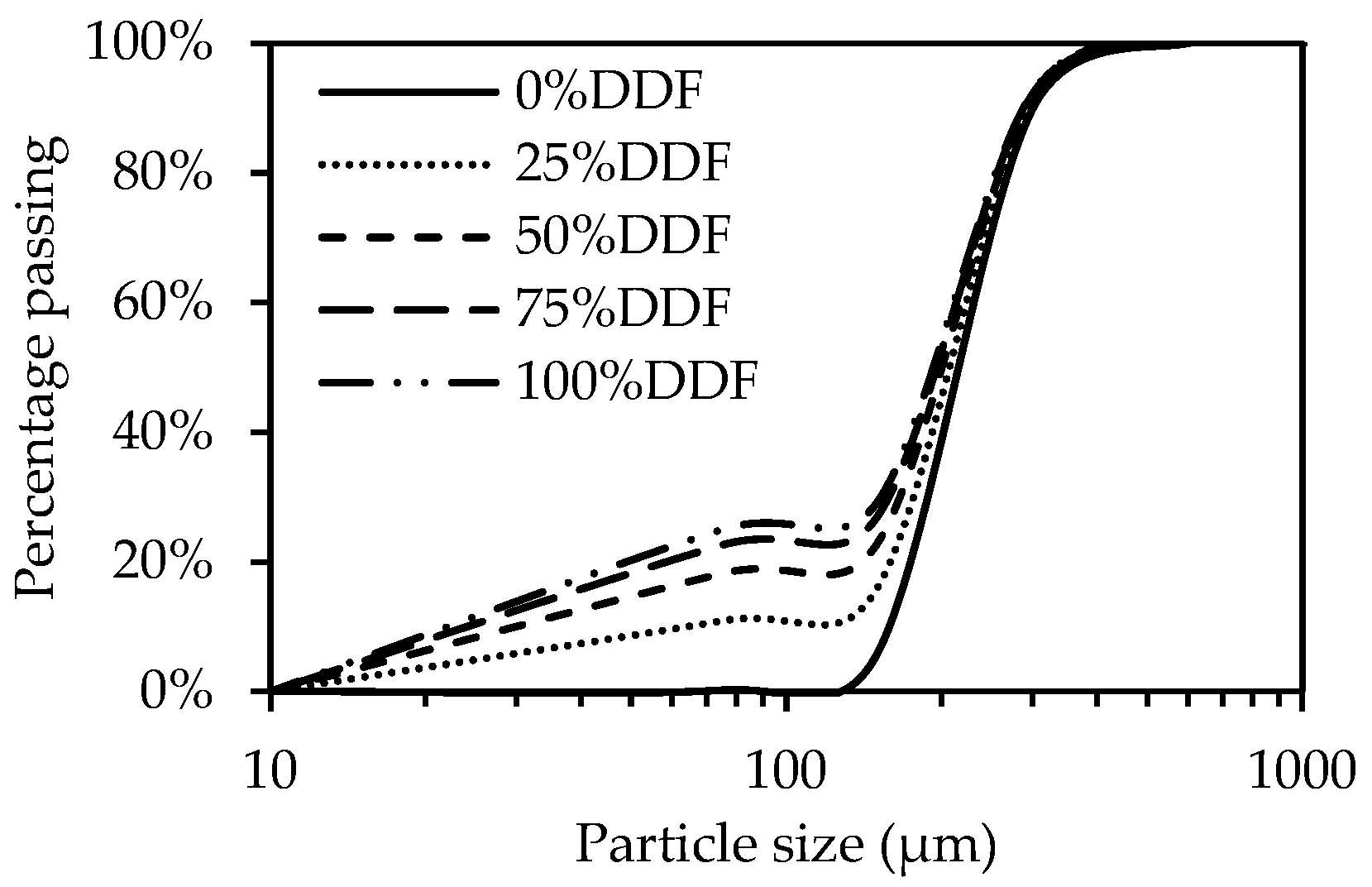
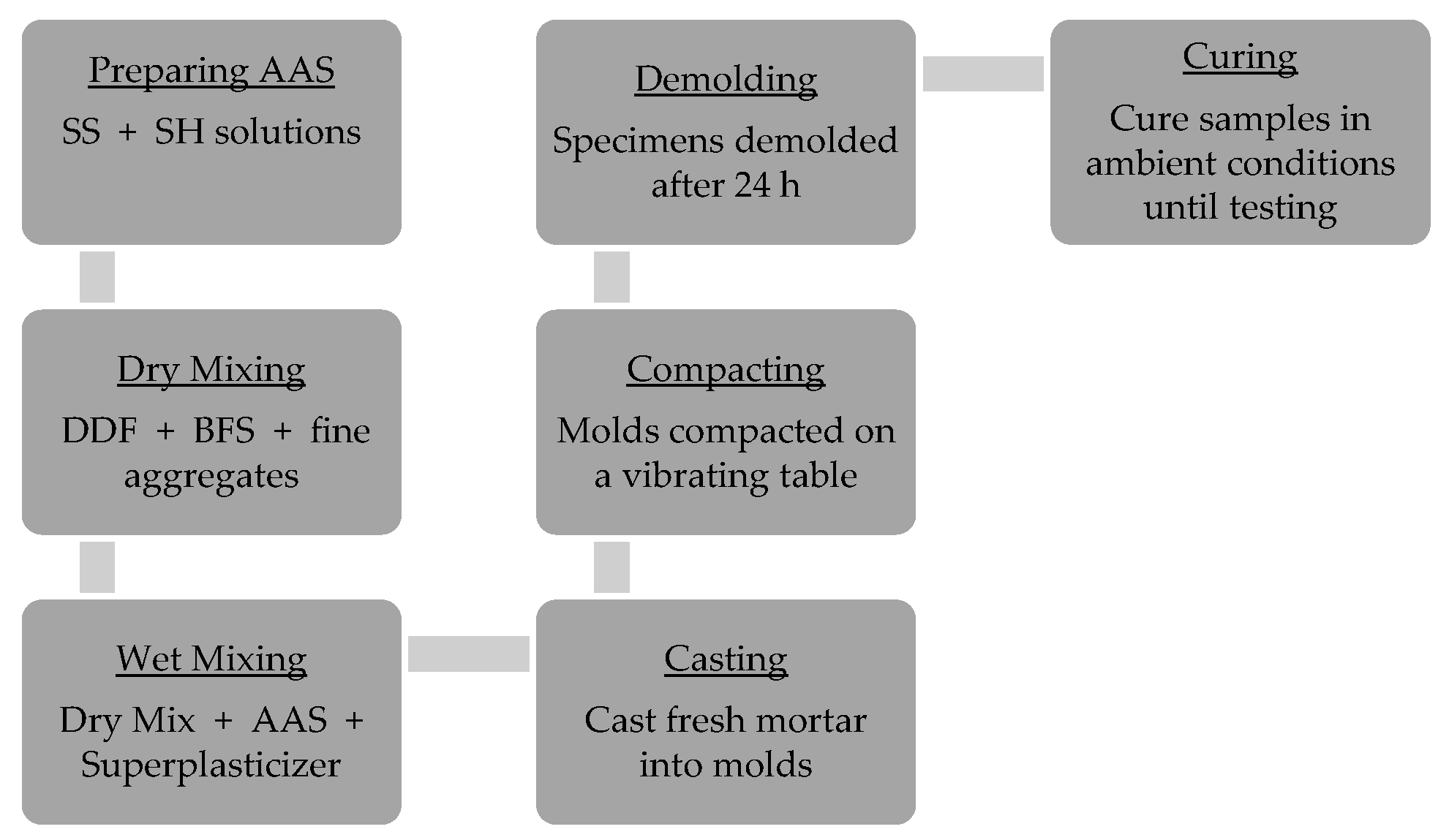


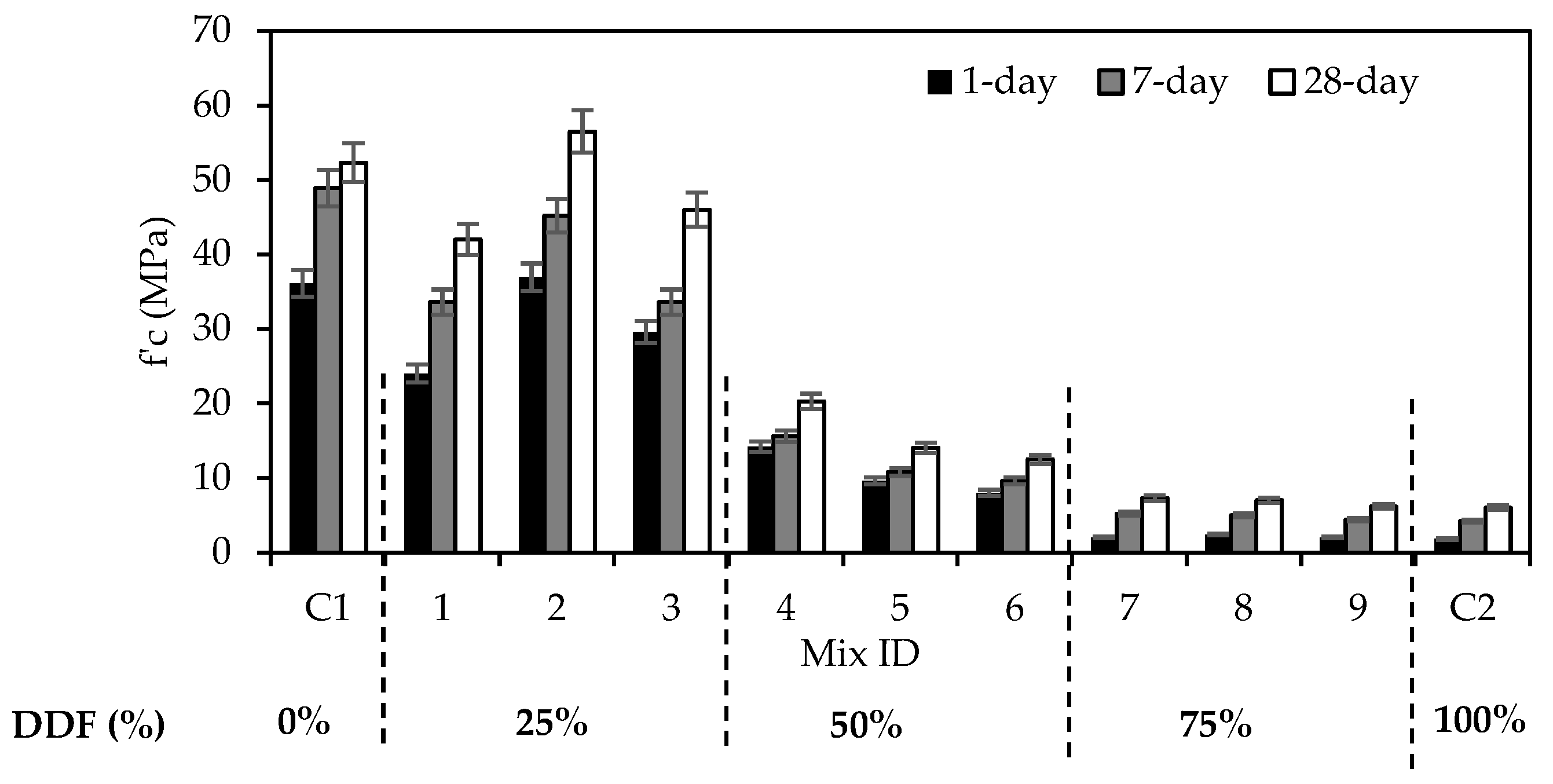
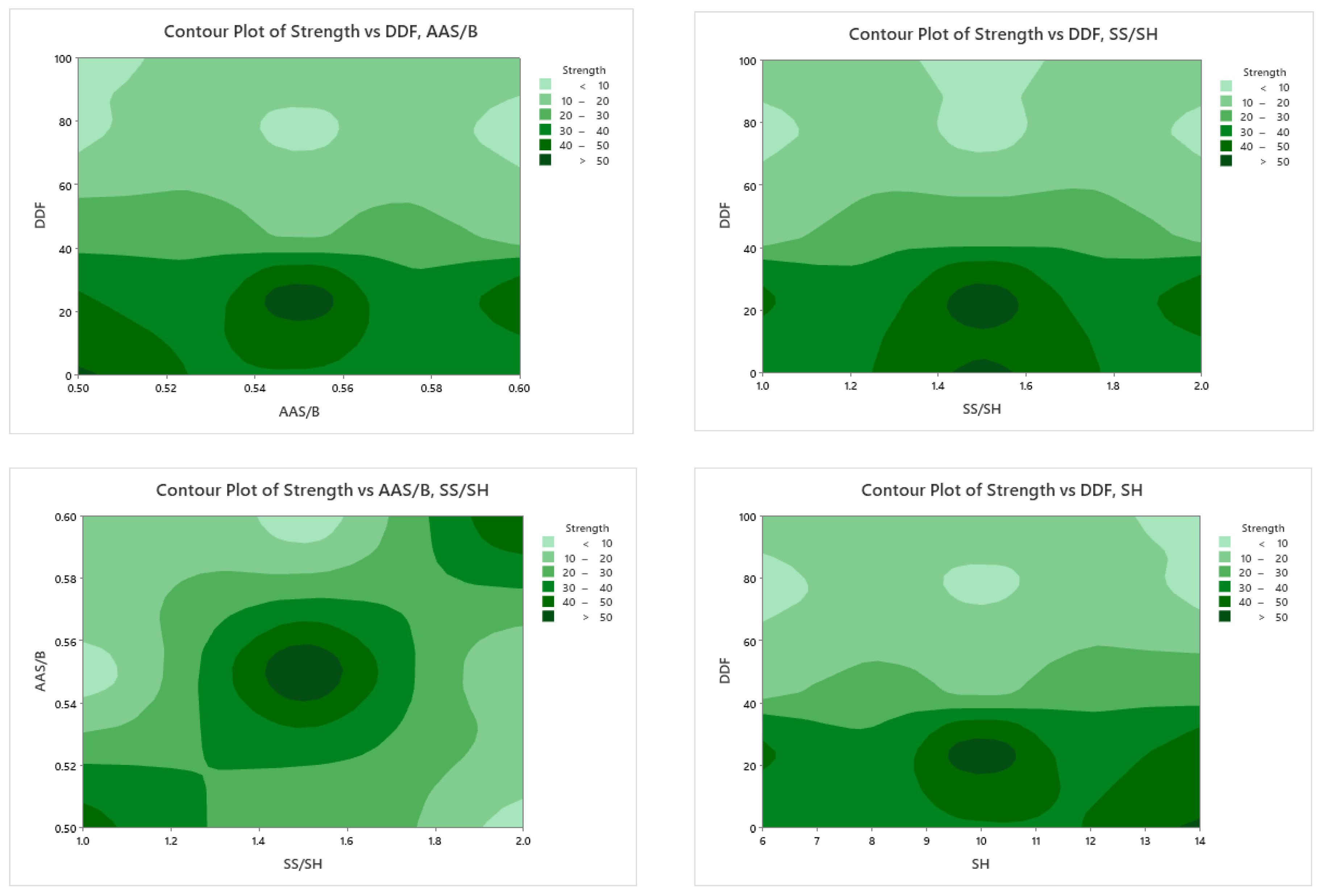
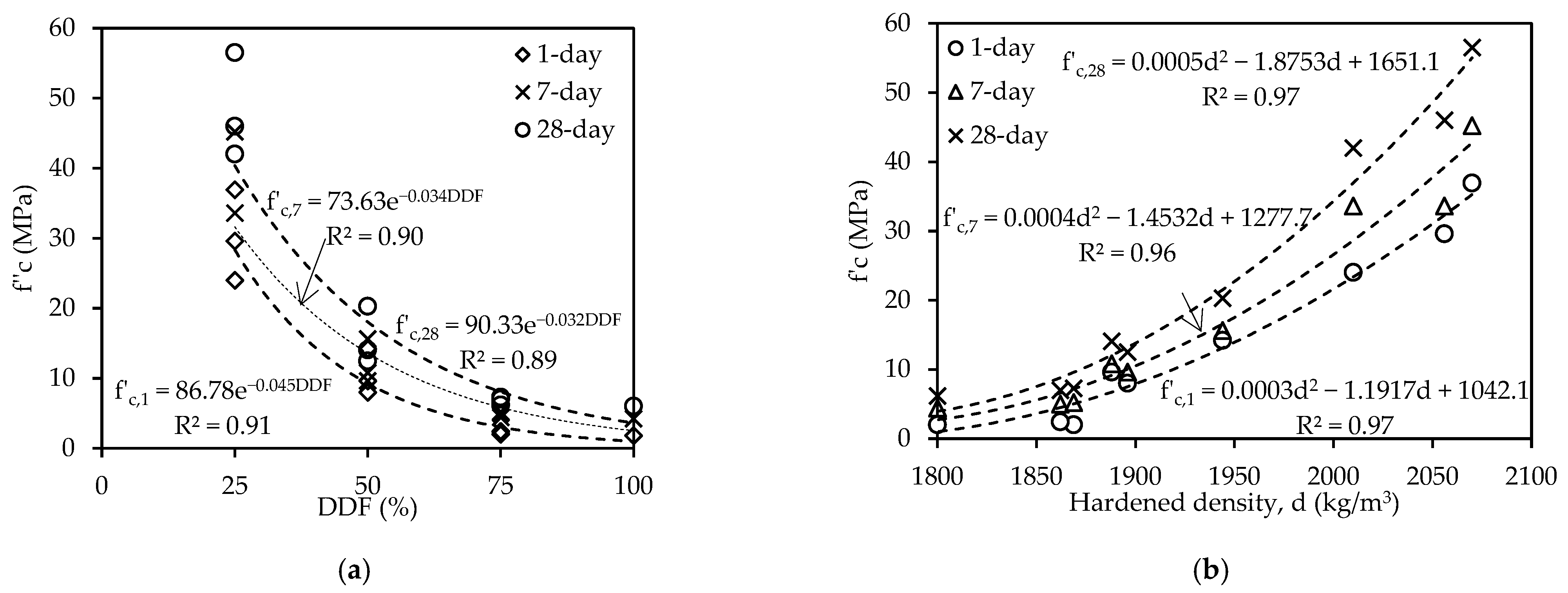


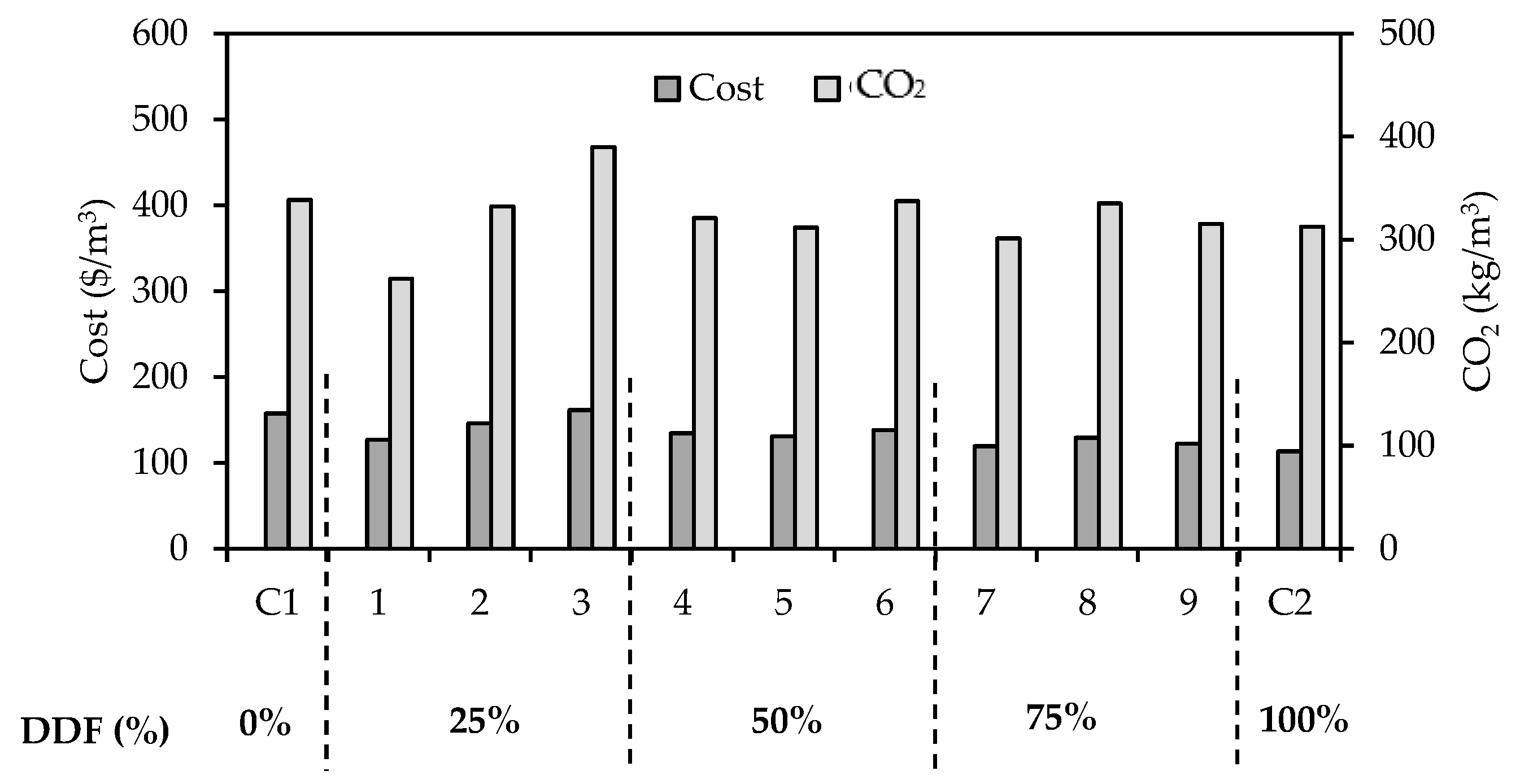

| Component | BFS (%) | DDF (%) |
|---|---|---|
| SiO2 | 35.4 | 64.9 |
| CaO | 42.1 | 14.1 |
| Al2O3 | 10.6 | 3.0 |
| Fe2O3 | 0.4 | 0.7 |
| MgO | 8.1 | 1.3 |
| SO3 | 0.3 | - |
| LOI | 3.1 | - |
| Physical characteristics | ||
| Specific gravity | 2.50 | 2.70 |
| Specific surface area, cm2/g | 4250 | 1820 |
| Mix ID | DDF (%) | AAS/B | SS/SH | SH (M) |
|---|---|---|---|---|
| 1 | 25 | 0.50 | 1.0 | 6 |
| 2 | 25 | 0.55 | 1.5 | 10 |
| 3 | 25 | 0.60 | 2.0 | 14 |
| 4 | 50 | 0.50 | 1.5 | 14 |
| 5 | 50 | 0.55 | 2.0 | 6 |
| 6 | 50 | 0.60 | 1.0 | 10 |
| 7 | 75 | 0.50 | 2.0 | 10 |
| 8 | 75 | 0.55 | 1.0 | 14 |
| 9 | 75 | 0.60 | 1.5 | 6 |
| Mix ID | BFS | DDF | Dune Sand | SS | SH | SP |
|---|---|---|---|---|---|---|
| 1 | 468.7 | 156.3 | 1210.7 | 156.3 | 156.3 | 12.5 |
| 2 | 468.7 | 156.3 | 1144.3 | 206.3 | 137.5 | 12.5 |
| 3 | 468.7 | 156.3 | 1076.5 | 250.0 | 125.0 | 12.5 |
| 4 | 312.5 | 312.5 | 1224.8 | 187.5 | 125.0 | 12.5 |
| 5 | 312.5 | 312.5 | 1156.6 | 229.2 | 114.6 | 12.5 |
| 6 | 312.5 | 312.5 | 1071.4 | 187.5 | 187.5 | 12.5 |
| 7 | 156.3 | 468.7 | 1236.7 | 208.3 | 104.2 | 12.5 |
| 8 | 156.3 | 468.7 | 1152.5 | 171.9 | 171.9 | 12.5 |
| 9 | 156.3 | 468.7 | 1086.7 | 225.0 | 150.0 | 12.5 |
| C1 | 625.0 | 0.0 | 1213.7 | 208.3 | 104.2 | 12.5 |
| C2 | 0.0 | 625.0 | 1244.3 | 208.3 | 104.2 | 12.5 |
| Materials | Cost ($/ton) | CO2 Footprint (kg/kg of Material) |
|---|---|---|
| BFS | 76 | 0.0416 |
| DDF | 5 | - |
| Dune Sand | 5 | - |
| SH Solid | 544 | 1.9150 |
| Water | 2 | 0.0126 |
| SS Liquid | 272 | 1.0000 |
| SP | 1927 | 1.8800 |
| Mix ID | Fresh Density (kg/m3) | Hardened Density (kg/m3) |
|---|---|---|
| 1 | 2220 ± 111 | 2010 ± 111 |
| 2 | 2240 ± 108 | 2070 ± 125 |
| 3 | 2232 ± 105 | 2056 ± 120 |
| 4 | 2224 ± 134 | 1944 ± 102 |
| 5 | 2224 ± 116 | 1888 ± 91 |
| 6 | 2128 ± 107 | 1896 ± 95 |
| 7 | 2168 ± 102 | 1868 ± 85 |
| 8 | 2168 ± 97 | 1862 ± 82 |
| 9 | 1900 ± 73 | 1800 ± 80 |
| C1 | 2250 ± 110 | 2065 ± 124 |
| C2 | 1810 ± 65 | 1680 ± 62 |
| Properties | Factors Contribution (%) | |||
|---|---|---|---|---|
| DDF% | AAS/B | SS/SH | SH Molarity | |
| Flow | 99.00 | 0.13 | 0.81 | 0.06 |
| Final setting time | 95.56 | 1.21 | 0.32 | 2.91 |
| Hardened density | 90.15 | 1.75 | 0.54 | 7.55 |
| 1-d f’c | 97.36 | 0.54 | 1.12 | 0.98 |
| 7-d f’c | 96.86 | 1.26 | 1.21 | 0.67 |
| 28-d f’c | 96.81 | 0.99 | 1.22 | 0.97 |
| Water absorption | 95.38 | 1.05 | 0.94 | 2.63 |
| Sorptivity | 92.33 | 1.44 | 2.12 | 4.10 |
| Cost | 51.25 | 21.11 | 2.76 | 24.88 |
| CO2(ft) | 0.94 | 46.22 | 8.44 | 44.40 |
| Quality Criteria | Factors and Levels | Optimum | |||||||||||
|---|---|---|---|---|---|---|---|---|---|---|---|---|---|
| A | B | C | D | ||||||||||
| 1 | 2 | 3 | 1 | 2 | 3 | 1 | 2 | 3 | 1 | 2 | 3 | ||
| Flow | 46.43 | 45.18 | 43.71 | 45.09 | 45.08 | 45.16 | 45.24 | 45.01 | 45.08 | 45.14 | 45.09 | 45.10 | A1B3C1D1 |
| Final setting time | 23.06 | 25.49 | 27.74 | 25.73 | 25.26 | 25.29 | 25.53 | 25.27 | 25.48 | 25.86 | 25.04 | 25.38 | A3B1C1D1 |
| Hardened density | 66.21 | 65.62 | 65.31 | 65.76 | 65.75 | 65.64 | 65.67 | 65.83 | 65.74 | 65.56 | 65.77 | 65.81 | A1B1C3D3 |
| 1-d f’c | 29.46 | 20.25 | 6.55 | 19.89 | 19.53 | 17.84 | 17.76 | 20.14 | 18.36 | 17.76 | 18.48 | 20.03 | A1B1C2D3 |
| 7-d f’c | 31.39 | 21.39 | 13.72 | 23.90 | 22.98 | 21.01 | 21.38 | 23.28 | 21.84 | 21.35 | 22.36 | 22.79 | A1B1C2D3 |
| 28-d f’c | 33.59 | 23.67 | 16.65 | 26.28 | 25.96 | 23.66 | 23.76 | 25.66 | 24.48 | 23.73 | 24.74 | 25.43 | A1B1C2D3 |
| Water absorption | −5.64 | −10.14 | −15.54 | −10.13 | −10.14 | −11.04 | −10.99 | −10.05 | −10.28 | −11.39 | −10.00 | −9.93 | A1B1C2D3 |
| Sorptivity | 1.89 | −1.41 | −6.91 | −1.72 | −1.81 | −2.78 | −2.88 | −1.56 | −1.99 | −3.22 | −1.50 | −1.22 | A1B1C2D3 |
| Cost | −43.18 | −42.57 | −41.38 | −42.06 | −42.61 | −42.91 | −42.37 | −42.53 | −42.68 | −42.05 | −42.54 | −42.98 | A3B1C1D1 |
| CO2 | −50.21 | −50.19 | −50.02 | −49.36 | −50.27 | −50.79 | −49.81 | −50.18 | −50.43 | −49.41 | −50.19 | −50.82 | A3B1C1D1 |
| Mix ID | Quality Criteria | |||||||||
|---|---|---|---|---|---|---|---|---|---|---|
| Q1 | Q2 | Q3 | Q4 | Q5 | Q6 | Q7 | Q8 | Q9 | Q10 | |
| 1 | 46.57 | 23.64 | 66.06 | 27.60 | 30.53 | 32.46 | −6.85 | 0.30 | −42.07 | −48.37 |
| 2 | 46.28 | 22.61 | 66.32 | 31.35 | 33.10 | 35.04 | −4.51 | 3.53 | −43.29 | −50.43 |
| 3 | 46.44 | 22.92 | 66.26 | 29.43 | 30.53 | 33.26 | −5.58 | 1.83 | −44.17 | −51.82 |
| 4 | 45.06 | 25.85 | 65.77 | 23.05 | 23.86 | 26.14 | −8.94 | −0.17 | −42.56 | −50.13 |
| 5 | 45.15 | 25.80 | 65.52 | 19.65 | 20.67 | 22.95 | −10.63 | −1.92 | −42.33 | −49.87 |
| 6 | 45.34 | 24.81 | 65.56 | 18.06 | 19.65 | 21.92 | −10.86 | −2.13 | −42.81 | −50.56 |
| 7 | 43.64 | 27.71 | 65.43 | 6.02 | 14.32 | 17.24 | −14.65 | −5.89 | −41.54 | −49.58 |
| 8 | 43.81 | 27.37 | 65.40 | 7.60 | 13.98 | 16.90 | −15.27 | −6.81 | −42.22 | −50.51 |
| 9 | 43.69 | 28.13 | 65.11 | 6.02 | 12.87 | 15.79 | −16.69 | −8.03 | −41.75 | −49.97 |
| Performance Criteria | S/N Target Value | Symbol | Weights | Normalized Weights |
|---|---|---|---|---|
| Flow | Larger is better | Q1 | 7 | 0.113 |
| Final setting time | Larger is better | Q2 | 8 | 0.129 |
| Hardened density | Larger is better | Q3 | 2 | 0.032 |
| 1-d f’c | Larger is better | Q4 | 8 | 0.129 |
| 7-d f’c | Larger is better | Q5 | 3 | 0.048 |
| 28-d f’c | Larger is better | Q6 | 10 | 0.161 |
| Water absorption | Smaller is better | Q7 | 5 | 0.081 |
| Sorptivity | Smaller is better | Q8 | 5 | 0.081 |
| Cost | Smaller is better | Q9 | 7 | 0.113 |
| CO2 | Smaller is better | Q10 | 7 | 0.113 |
| Mix | Q1 | Q2 | Q3 | Q4 | Q5 | Q6 | Q7 | Q8 | Q9 | Q10 | Si+ | Si− | Ci* |
|---|---|---|---|---|---|---|---|---|---|---|---|---|---|
| 1 | 0.039 | 0.040 | 0.011 | 0.056 | 0.021 | 0.068 | −0.016 | 0.002 | −0.037 | −0.036 | 0.024 | 0.081 | 0.77 |
| 2 | 0.039 | 0.038 | 0.011 | 0.064 | 0.023 | 0.074 | −0.011 | 0.022 | −0.038 | −0.038 | 0.010 | 0.102 | 0.914 |
| 3 | 0.039 | 0.039 | 0.011 | 0.060 | 0.021 | 0.070 | −0.013 | 0.011 | −0.039 | −0.039 | 0.015 | 0.091 | 0.854 |
| 4 | 0.038 | 0.044 | 0.011 | 0.047 | 0.016 | 0.055 | −0.021 | −0.001 | −0.038 | −0.038 | 0.037 | 0.067 | 0.647 |
| 5 | 0.038 | 0.044 | 0.011 | 0.040 | 0.014 | 0.048 | −0.025 | −0.012 | −0.037 | −0.037 | 0.052 | 0.052 | 0.501 |
| 6 | 0.038 | 0.042 | 0.011 | 0.037 | 0.014 | 0.046 | −0.026 | −0.013 | −0.038 | −0.038 | 0.055 | 0.048 | 0.465 |
| 7 | 0.036 | 0.047 | 0.011 | 0.012 | 0.010 | 0.036 | −0.035 | −0.036 | −0.037 | −0.037 | 0.091 | 0.017 | 0.158 |
| 8 | 0.037 | 0.046 | 0.011 | 0.016 | 0.010 | 0.035 | −0.037 | −0.042 | −0.037 | −0.038 | 0.094 | 0.012 | 0.116 |
| 9 | 0.036 | 0.047 | 0.011 | 0.012 | 0.009 | 0.033 | −0.040 | −0.050 | −0.037 | −0.038 | 0.102 | 0.010 | 0.086 |
| Properties | α0 (DDF) | α1 (AAS/B) | α2 (SS/SH) | α3 (SH Solution) | α4 (Intercept) | RMSE | R2 |
|---|---|---|---|---|---|---|---|
| Flow | −1.140 | 58.820 | −3.330 | −0.693 | 216.620 | 5.83 | 0.98 |
| Final setting time | 0.171 | −30.052 | 0.610 | 0.149 | 25.463 | 3.02 | 0.83 |
| Hardened density | −3.920 | 114.860 | 14.900 | 2.450 | 2007.470 | 48.36 | 0.90 |
| 1-d f’c | −0.436 | −11.810 | 2.266 | 0.564 | 33.900 | 6.45 | 0.87 |
| 7-d f’c | −0.534 | −45.270 | 0.466 | 0.507 | 64.730 | 8.15 | 0.86 |
| 28-d f’c | −0.619 | −26.835 | 1.940 | 0.590 | 60.740 | 10.74 | 0.83 |
| Water absorption | 0.066 | 1.645 | −0.263 | −0.025 | 0.289 | 0.86 | 0.89 |
| Sorptivity | 0.023 | 0.567 | −0.135 | −0.001 | 0.269 | 0.32 | 0.88 |
Publisher’s Note: MDPI stays neutral with regard to jurisdictional claims in published maps and institutional affiliations. |
© 2022 by the authors. Licensee MDPI, Basel, Switzerland. This article is an open access article distributed under the terms and conditions of the Creative Commons Attribution (CC BY) license (https://creativecommons.org/licenses/by/4.0/).
Share and Cite
El-Mir, A.; El-Hassan, H.; El-Dieb, A.; Alsallamin, A. Development and Optimization of Geopolymers Made with Desert Dune Sand and Blast Furnace Slag. Sustainability 2022, 14, 7845. https://doi.org/10.3390/su14137845
El-Mir A, El-Hassan H, El-Dieb A, Alsallamin A. Development and Optimization of Geopolymers Made with Desert Dune Sand and Blast Furnace Slag. Sustainability. 2022; 14(13):7845. https://doi.org/10.3390/su14137845
Chicago/Turabian StyleEl-Mir, Abdulkader, Hilal El-Hassan, Amr El-Dieb, and Abdelrahman Alsallamin. 2022. "Development and Optimization of Geopolymers Made with Desert Dune Sand and Blast Furnace Slag" Sustainability 14, no. 13: 7845. https://doi.org/10.3390/su14137845
APA StyleEl-Mir, A., El-Hassan, H., El-Dieb, A., & Alsallamin, A. (2022). Development and Optimization of Geopolymers Made with Desert Dune Sand and Blast Furnace Slag. Sustainability, 14(13), 7845. https://doi.org/10.3390/su14137845






